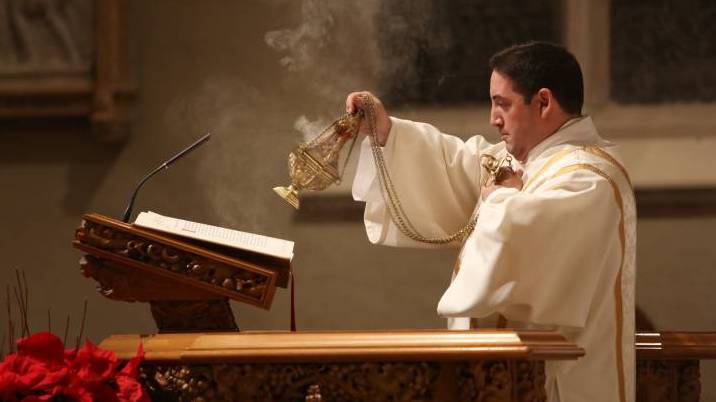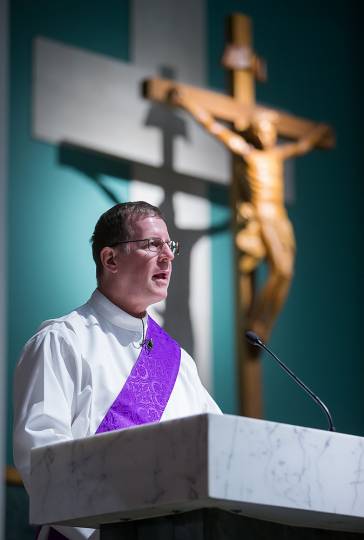



Deacon-structing the Mass | Part 6: Homily, Creed, and Universal Prayers
Deacon Pedro
Sunday, September 16, 2018

Salt + Light
So far in this series we’ve learned that we have to participate fully, consciously and actively in the Mass. We have briefly looked at several parts of the Mass including the Entrance, the Penitential Rite, the Gloria, and the Liturgy of the Word. Last time we specifically looked at the Readings and the Gospel. Today we will continue with the Liturgy of the Word.
We learned that if there is a deacon, the deacon is the ordinary minister of the Gospel: He must be the one proclaiming the Gospel.
During the Alleluia, the deacon or priest will walk to the ambo. If there is a Book of the Gospels, it will be brought in procession to the ambo. It is appropriate for this procession to include two candles and may include incense. At the ambo, the priest or deacon opens the book and, with hands joined, says, "The Lord be with you” (Dominus vobiscum), and the people respond, “And with your spirit” (Et cum spiritu tuo). Then, when he announces the Gospel reading, he makes the Sign of the Cross with his thumb on the Book and then on his forehead, mouth, and breast. The whole congregation also makes the sign of the cross over their forehead, mouth, and breast as they respond "Glory to you, O Lord" (Gloria tibi, Domine). (I say a short prayer while I make the Sign of the Cross: “That I may believe it, preach it, and live it.” That’s a good reminder of why it’s my forehead, my lips, and my heart.) If incense is being used, the priest or deacon will then incense the Book before proclaiming the Gospel.
At the end of the Gospel, the deacon or priest says the acclamation: “The Gospel of the Lord” (Verbum Domini), and all respond, “Praise to you, Lord Jesus Christ” (Laus tibi, Christe). He then venerates the Book with a kiss, saying privately, “Through the words of the Gospel may our sins be wiped away.”
If the deacon is assisting the Bishop, he generally carries the Book to him to be kissed (but not necessarily. In my experience it depends on the Bishop and this depends on how easy it is to walk back to the Presider’s chair. Still, 9 out of 10 times, the Bishop will want to venerate the Book). In more solemn celebrations, as the occasion suggests, a Bishop may impart a blessing to the people with the Book of the Gospels.
Lastly, the deacon may carry the Book of the Gospels to the credence table or to another appropriate and dignified place.

 Every week, Deacon Pedro takes a particular topic apart, not so much to explore or explain the subject to its fullness, but rather to provide insights that will deepen our understanding of the subject. And don’t worry, at the end of the day he always puts the pieces back together. There are no limits to deaconstructing: Write to him and ask any questions about the faith or Church teaching: [email protected]
Every week, Deacon Pedro takes a particular topic apart, not so much to explore or explain the subject to its fullness, but rather to provide insights that will deepen our understanding of the subject. And don’t worry, at the end of the day he always puts the pieces back together. There are no limits to deaconstructing: Write to him and ask any questions about the faith or Church teaching: [email protected]
After the Gospel Reading we all sit down and prepare to listen to the Homily.
The General Instruction of the Roman Missal says that the homily is “necessary for the nurturing of the Christian life.” In fact, both the Constitution on the Sacred Liturgy and the General Instruction declare that on Sundays and feasts, the homily may not be omitted without a grave reason (GIRM 66). The homily is so important because it is the essential means by which the Scriptures are brought into dialogue with the events and situations in our daily lives. It should lead us as individuals and as a community to celebrate God’s mighty deeds among us joyfully, actively, and worthily in the Liturgy of the Eucharist. The homily should be based on some aspect of the day’s Scripture or of another text from the Mass of the day, or on the celebration as a whole. I will not dedicate more time to this because I have written extensively on the topic. (Refer to Deacon-structing the Word, part 1, part 2, part 3, part 4, and part 5), but I will say that the homily is our bridge between the table of the word and the table of the Eucharist. So often the homily feels like it’s an “insert” in the Mass. It should, instead, feel like it’s very much a part of the full celebration and as much connected to the Eucharist that is to come, as it is to the readings. It should inspire us to see that it is indeed “right and just” to “give thanks to the Lord our God.” As a rule the homily is to be given by the priest celebrant or a con-celebrating priest. A deacon may also be delegated to preach the homily on occasion. Because of the bridging function of the homily, the General Instruction does not make any provision for a homilist who is not present for the whole celebration. It is then appropriate for a brief period of silence to be observed after the homily.
The Profession of Faith
The Profession of Faith is the Creed and is proclaimed mainly on Sundays and Solemnities. It is our first response to the Word of God proclaimed in the Scriptures and in the homily. We have the option of using either the Apostles’ Creed, the oldest profession of the faith of the Roman Church, or the Nicene Creed. The praying of the Creed highlights the place of the particular themes of the day in the whole of salvation history, which we believe and which will be celebrated in the Liturgy of the Eucharist. The Creed can be sung or spoken and is done together by everyone standing. At the words “and by the Holy Spirit was incarnate of the Virgin Mary, and became man” or “who was conceived by the Holy Spirit, born of the Virgin Mary” all make a profound bow.The Universal Prayer
After the Profession of Faith, we continue to respond to the Word of God with the offering of prayers of petition on behalf of the Church and the world in the Universal Prayer, commonly known as the Prayers of the Faithful. The General Instruction suggests that the series of intentions is to be: a) for the needs of the Church; b) for public authorities and the salvation of the whole world; c) for those burdened by any kind of difficulty; and d) for the local community. In any particular celebration (as in a Marriage or Funeral), the intentions may be concerned more closely with the particular occasion. In formulating the particular intentions for the day we must remember that we pray for the needs of others. It is appropriate to pray for special graces and worldly needs according to the particular circumstances of the ones for whom we pray; it is not appropriate to dictate specific behaviours or behavioural changes or the means by which God should achieve what is asked. The Presider begins the prayer with a brief introduction, by which he calls upon the faithful to pray, and he concludes it with a summary prayer. The intentions are announced from the ambo or from another suitable place, by the Deacon or a reader. They may be sung by a cantor, and the community’s response may be sung or spoken. If there is a deacon, the prayers should be read by the deacon. In fact, I was told in diaconal formation that it is appropriate for the deacon to compose the Prayers of the Faithful each week, as he is in touch with the needs of the community. There is no provision in the General Instruction for adding devotional prayers, such as the Hail Mary, at the close of these prayers. When all of this is finished, everyone sits, and we begin the Offertory. Come back next week as we begin to look at the Liturgy of the Eucharist. [Most of the information used in these blog posts, comes from the text of a video made by Salt + Light Television in partnership with the National Liturgy Office of the Canadian Conference of Catholic Bishops in 2011, to help explain the latest changes to the language of the English Roman Missal, titled, THE CELEBRATION OF EUCHARIST for the Twenty-First Century. The project was headed by Fr. Bill Burke and the text of that video was written by Canadian liturgist Margaret Bick, both of whom I owe a great deal of thanks for the vast knowledge they shared with us.] - Image: Deacon Bruce Fraser speaks during a Dec. 17 Mass for migrant workers at Our Lady of Sorrows Church in Vancouver, British Columbia. (CNS photo/Ben Nelms) Every week, Deacon Pedro takes a particular topic apart, not so much to explore or explain the subject to its fullness, but rather to provide insights that will deepen our understanding of the subject. And don’t worry, at the end of the day he always puts the pieces back together. There are no limits to deaconstructing: Write to him and ask any questions about the faith or Church teaching: [email protected]
Every week, Deacon Pedro takes a particular topic apart, not so much to explore or explain the subject to its fullness, but rather to provide insights that will deepen our understanding of the subject. And don’t worry, at the end of the day he always puts the pieces back together. There are no limits to deaconstructing: Write to him and ask any questions about the faith or Church teaching: [email protected]Related Articles:
<<
SUPPORT LABEL
$50
$100
$150
$250
OTHER AMOUNT
DONATE
Receive our newsletters
Stay Connected
Receive our newsletters

Stay Connected







